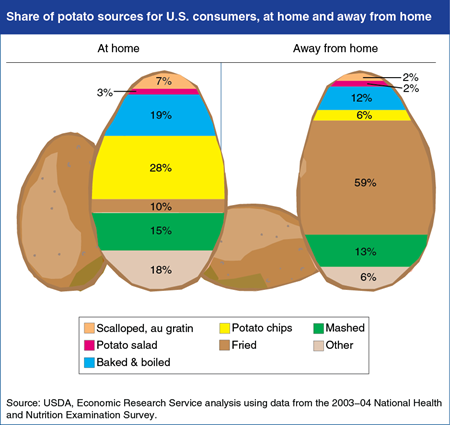Editor's Pick 2014: Best of Charts of Note
This chart gallery is a collection of the best Charts of Note from 2014. These charts were selected by ERS editors as those worthy of a second read because they provide context for the year’s headlines or share key insights from ERS research.

When advised to “eat your vegetables,” Americans may also need to be reminded “and watch how you prepare them.” ERS researchers recently looked at the types of vegetables and vegetable-containing foods eaten by Americans and found that instead of eating vegetables in their simple, unadorned state, Americans often eat vegetables in ways that add calories and sodium and reduce dietary fiber. For potatoes prepared at home, potato chips were the most commonly eaten form, accounting for 28 percent of potato consumption. In restaurants, fast food places, and other away from home eating places, fried potatoes accounted for 59 percent of potato consumption. Food intake surveys show other potato dishes, such as mashed and scalloped potatoes, are often prepared with added fats and sodium. Baked and boiled potatoes accounted for 19 percent of at-home potato consumption and 12 percent away from home, and the skin was usually not eaten, reducing dietary fiber content. This chart appears in “Healthy Vegetables Undermined by the Company They Keep” in the May 2014 issue of ERS’s Amber Waves magazine. Originally published Monday August 11, 2014.
_450px.png?v=9662.3)
If you have a sweet tooth, you are not alone. A recent analysis of intake data from the 2007-10 National Health and Nutrition Examination Survey (NHANES) found that U.S. children ate an average of 9.7 teaspoons of added sugars for each 1,000 calories consumed, and adults consumed 8.4 teaspoons of added sugars per 1,000 calories. Added sugars are the sugars, syrups, and other caloric sweeteners added to foods, including table sugar added to coffee and high fructose corn syrup used in soft drinks, ketchup, and other processed foods. The 2010 Dietary Guidelines for Americans advise that added sugars and added fats should account for no more than 258 calories of a 2,000-calorie diet. Half of this maximum coming from added sugars would equal 3.9 teaspoons per 1,000 calories—less than half of what Americans are consuming. The analysis also found that on average, lower-income individuals consumed more added sugars than higher-income individuals. This chart appears in “Food Consumption and Nutrient Intake Data—Tools for Assessing Americans’ Diets” in the October 2014 issue of ERS’s Amber Waves magazine. Originally published Friday October 10, 2014.

